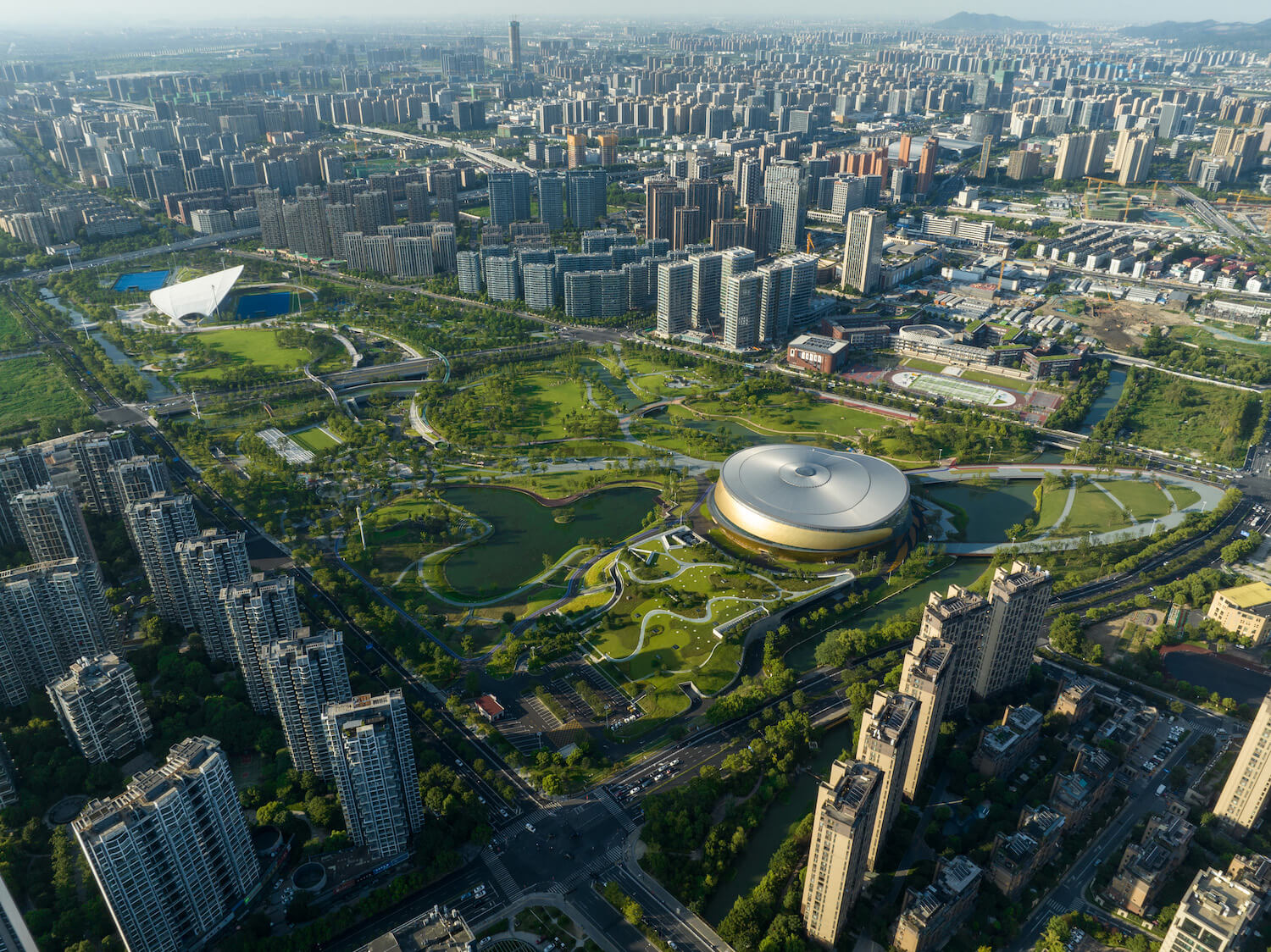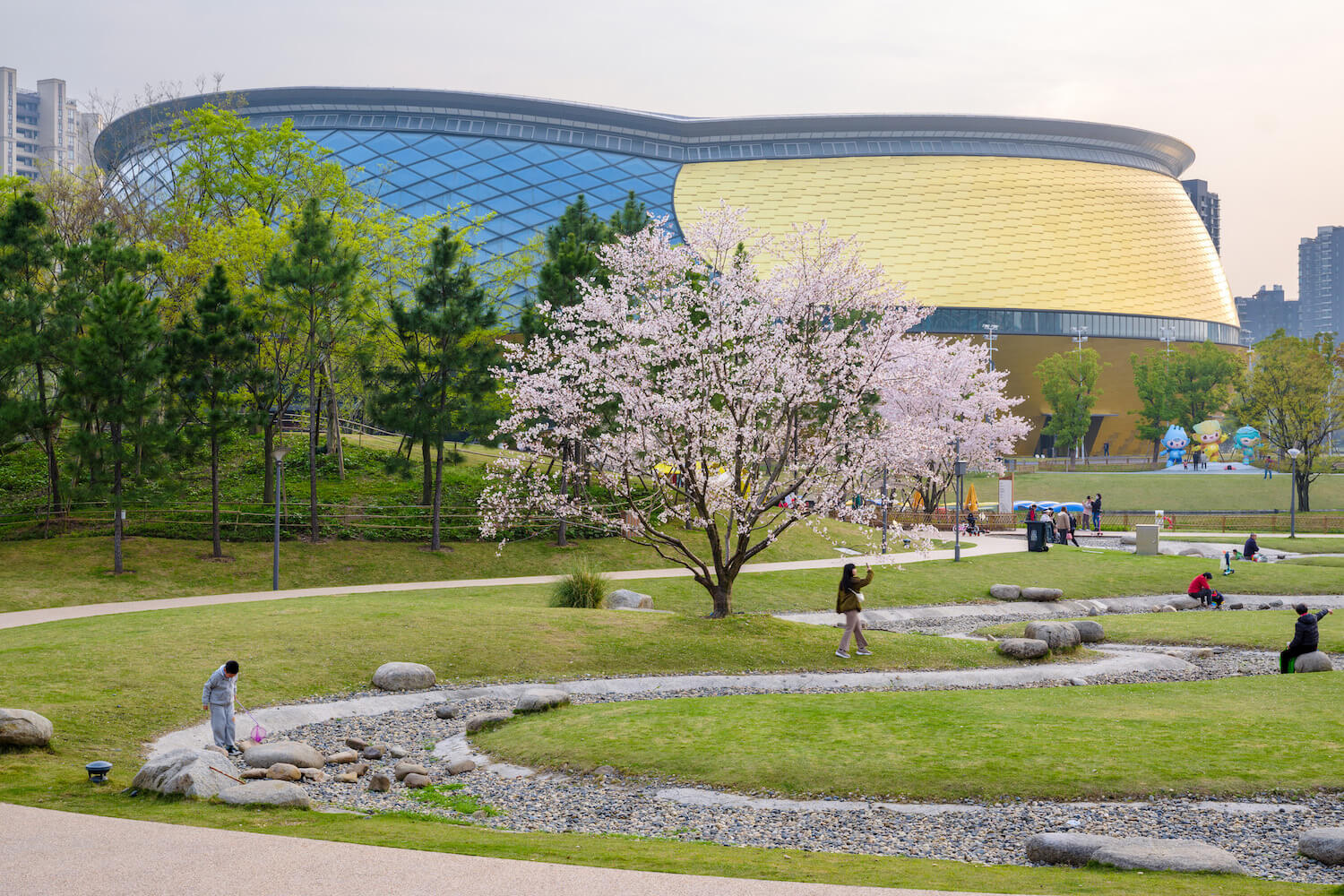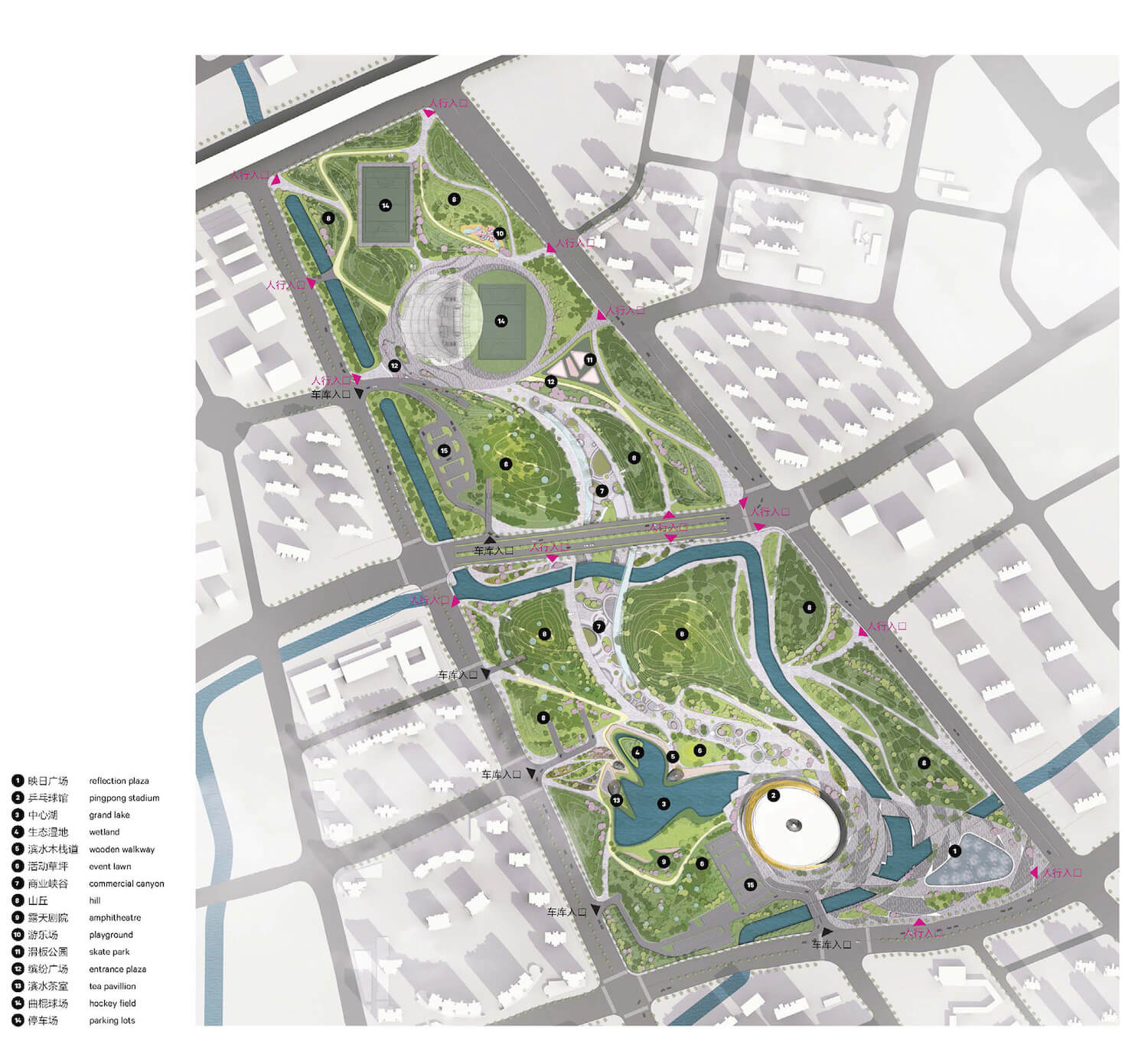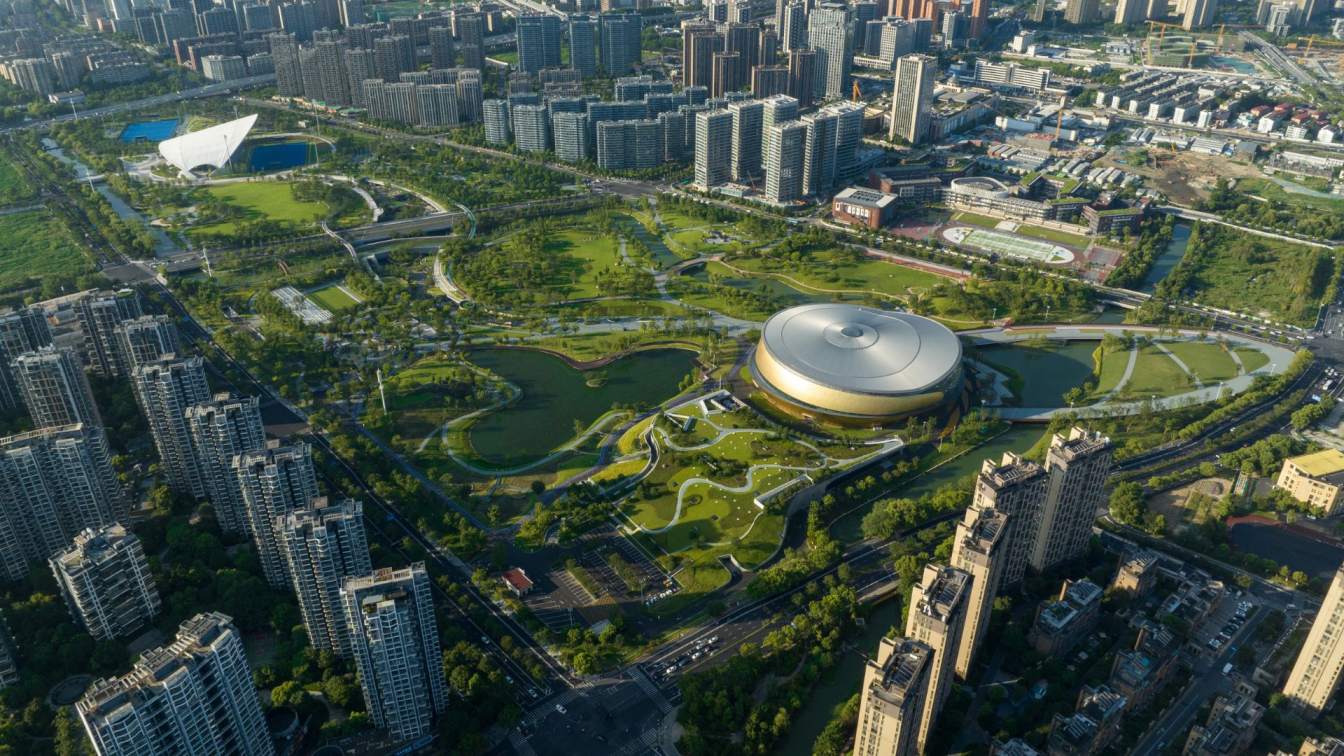Archi-Tectonics NYC and !Melk won this invited competition in 2018 and developed the design in collaboration with the LDI, ZIAD Hangzhou. The sweeping masterplan was inserted with a 116-acre [47-hectare] Eco park and 7 buildings into a densely built skyscraper district of Hangzhou, one of China’s fastest-growing cities. Though the park was commissioned for the upcoming Hangzhou Asian Games 2022, the team looked beyond that event to set a new course for the city’s environmental future.
Designed with a ‘Sponge-City’ landscape strategy, the project introduces a hilly oasis programmed for round-the-year recreation that doubles as a green lung, restoring the local biome and strengthening its hydrology. The project achieved “Green Building Evaluation Label 3 Star” (GBEL 3 Star), the highest level of sustainability in China and equivalent to LEED Platinum. The project saved substantial steel and overall costs through BIM optimization, shortening the construction time by over 20% to just 3 years. The design inserts 7 new green buildings for the Games that will convert to community use after, with a mix of natural reserves, hiking paths, water features, playgrounds and landforms that double as sustainability infrastructure like restored wetlands, porous pavement and stormwater management.
The Masterplan’s combined green roofs in the park cover 64,000 m² and can absorb 114,846 kg of CO2/year and release 83,408 kg of O2/year. During the Hangzhou Asian Games 2022—the second-largest international athletics competition after the Olympics—the park will be the hub where spectators gather between events and move between the venues. Once the Games end, it will become a neighborhood green space programmed with a mix of activities—including kayaking, running, hiking, skateboarding, and sports fields—to cater to the city's entire population, from children and young professionals to the elderly.

It is designed to plug into and strengthen Hangzhou's existing fabric and infrastructure, bringing much-needed green space to the dense city and acting as an ‘urban sponge’ and a green lung that collects, filters, and re-uses storm-water runoff. “We designed the park as an agent of environmental change in the city,” says Winka Dubbeldam, Founding Partner of Archi-Tectonics. “It sets a new standard for Hangzhou as a greener, more resilient city. Future urban masterplans will look to it as a model of sustainable density.”
Village Valley Mall
The plan sites two game venues—the Field Hockey Stadium and the Hybrid Table Tennis Stadium—at either end of the mile-long site. The park is bisected by a road and river and a shopping ‘Valley Village’ concept was developed to act as a connector of the 2 halves of the park, creating a social artery. The Valley Village Mall is conceived as a recessed green valley with circular glass shopping pavilions. Two parking garages flank the shopping area and connect underground for delivery access. Each of the buildings offers fire egress at grade.
“Originally, the entire mall was supposed to be underground,” says Winka Dubbeldam. “Instead, we made it into a shopping valley landscape with green pavilions, creating an open-air social core that feels connected to surrounding landscapes and city. We were challenged by the fact that only 15% of the project could be visible above ground, as 85% had to be park.”
The Village Valley Mall is lined with shops, restaurants, cafes, kiosks, and outdoor gathering areas, positioning it as the social core of the park. Permeable pavement minimizes storm-water runoff. Each store pavilion is topped with green roofs that enhance water retention, extend the landscape, and offer places where visitors can relax, picnic, and take in the surroundings. Custom-designed Solar Wings shade the Valley Village while generating electricity and lighting for the park. They also push wind into the Village Valley to generate a comfortable micro-climate.

Zero-Earth Landscape Strategy
Digging out the wetlands and the Valley Village to connect the 2 halves of the park made it possible to shape the previously flat site into a landscape of rolling hills that rise more than 20 meters above grade without bringing in additional soil, adhering to a ‘zero-earth’ strategy to minimize the environmental impact of soil removal. Several new hills function as nature reserves, promoting biodiversity and ecological conservation. Beneath the landscape, an interconnected network arraying 68,000 sm of parking spaces and passageways connects all the buildings and stadiums. The underground network offers efficient back-of-house services, deliveries, and access to all park areas without disrupting the natural landscape above. It also hosts a cinema, creating another leisure destination in the city.
Sponge City: Water Features for Recreation and Resilience
The design implements the Sponge City model, incorporating extensive waterways that enhance hydrology and open new possibilities for recreational programming. An artificial river snakes through the site, passing over the Village Valley as an aqueduct beside a roadway that creates access for VIPs during the games. The river forms a crucial part of the wetland systems, mitigating stormwater runoff and offsetting the impact of newly built areas. It also doubles as a kayaking route and creates a scenic element overlooked by the hills and the Village Valley Mall. Islands in the river generate a quicker current, naturally cleaning the water and oxygenating it.
Mobility in Chain [MIC] was hired to make this park as accessible and easy to navigate as possible. Escalators from the Valley Village create access from the deepest points of the shopping artery back to the bisecting road while elegantly curving pedestrian bridges traverse the hilly landscape to connect over the road & river. Several bridges cross the river to fluidly re-integrate the park into the surrounding neighbourhood’s infrastructure.































About Archi-Tectonics NYC LLC [ATS]
Founded in 1994 by Professor Winka Dubbeldam, Archi-Tectonics NYC, LLC is a WBE-certified design studio with offices in New York City, Amsterdam, and Hangzhou. Dubbeldam and Justin Korhammer, partner since 2016, lead a multi-national team of architects, urbanists, industrial designers, and engineers that work across scales and types. The studio’s design approach is rooted in systems thinking, exploring the interrelations between cities, buildings, environments, and objects, and developing innovative designs optimized across all aspects of a project—from parametric and manufacturing to performance and user experience. Resulting in buildings that have character and identity that derive inspiration from the far past to excel in the global future. Professor Winka Dubbeldam is also the Chair of the Department of Architecture at the Weitzman School of Design at the University of Pennsylvania, Philadelphia, USA.

